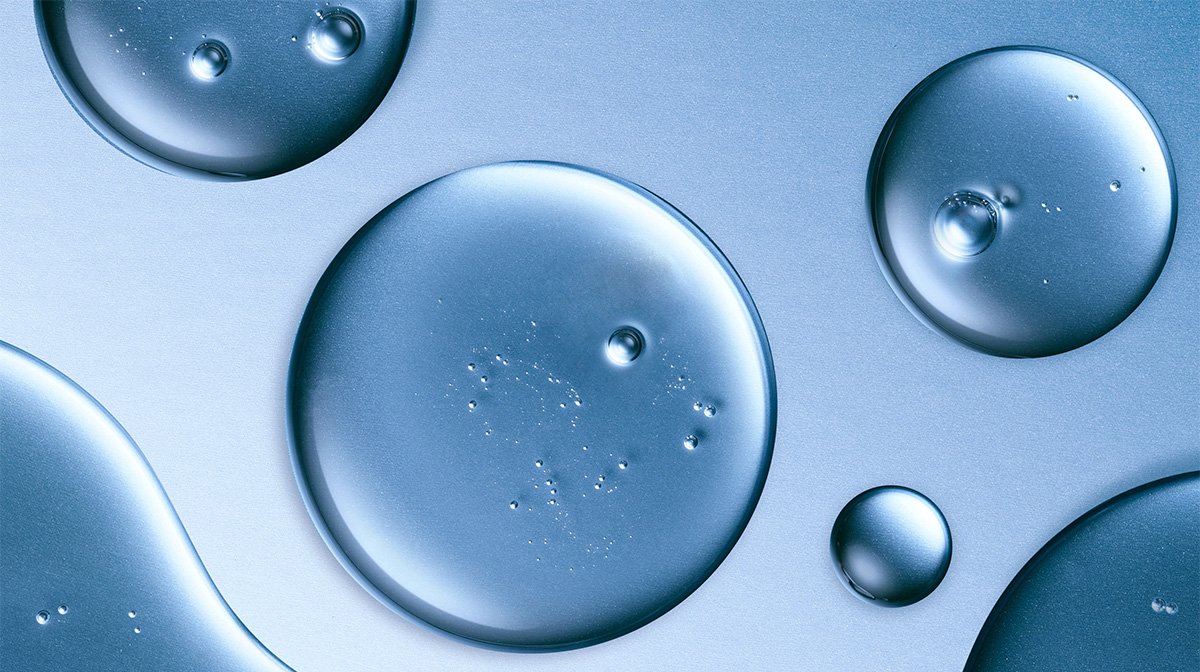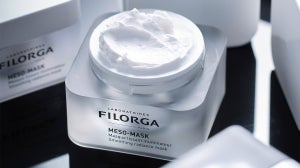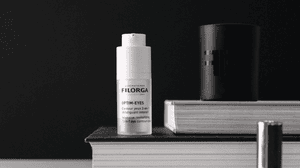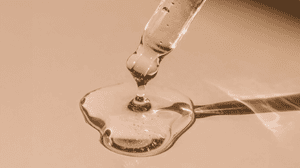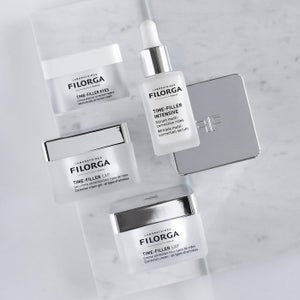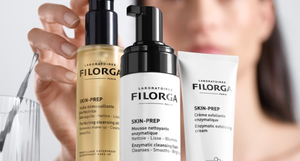
Hyaluronic acid first appeared on the cosmetic scene in the early 1990s and its popularity has continued to grow ever since. However, few people know what this very special acid actually is. Is it a natural or chemical ingredient? How does it work on the skin? Is it only used in beauty products? Is it really acidic?
In this article, Laboratoires FILORGA’s experts give you a guided tour of the history of hyaluronic acid, from its discovery almost 100 years ago to its current cosmetic applications. Find out everything you need to know about this essential ingredient and how it helps combat skin ageing.
What is hyaluronic acid?
Hyaluronic acid is a long natural molecule belonging to the carbohydrate family. However, it has nothing to do with the carbohydrates found in rice or fruit. If we were to compare it to a common nutrient, hyaluronic acid would be closest to fibres, because like them, it is able to absorb a lot of water and provides mechanical strength to the ingredients it is mixed with.
Of course, the comparison ends there. But before going into the details of its properties and effects, let's take a look at its history.
The origins
Hyaluronic acid was first identified in 1934 by ophthalmic researchers Karl Meyer and John Palmer. It was first isolated from the vitreous humour (the part of the eye behind the pupil and lens) of an ox and takes its name from the Greek word hyalos, meaning "vitreous". Hyaluronic acid is also present in the synovial fluid of joints and of course in the skin.
Later, from the 1950s to the 2000s, the medical potential of hyaluronic acid was mainly promoted by the Hungarian biochemist Endre Balazs.
Where does the hyaluronic acid used by Laboratoires FILORGA come from?
The hyaluronic acid used by FILORGA is of natural origin, obtained through white biotechnological processes using wheat grain. To make the white flour that is used in cakes, millers use only the kernel of the wheat grain. The husk, also known as wheat bran, is left out. Instead of being discarded, the wheat bran is used as an ingredient in the production of hyaluronic acid.
During a process of bio-fermentation, the wheat bran is 'fed' to lactic acid bacteria resulting in the natural production of hyaluronic acid, which is then isolated and purified. Most importantly, the hyaluronic acid obtained has a chemical structure identical to that of the hyaluronic acid present in the skin. It is therefore readily absorbed, minimising the risk of any inflammatory reactions.
Hyaluronic acid is not just for cosmetics
As we will see later, hyaluronic acid has numerous beneficial effects on the skin, but it is also used in other areas.
In rheumatology
Hyaluronic acid is useful in the treatment of osteoarthritis. When osteoarthritis develops, the synovial fluid that lubricates our joints becomes less viscous and less effective, which can lead to pain and inflammation. Injecting hyaluronic acid directly into the joint can help reinvigorate synovial fluid and improve lubrication, reducing pain and inflammation and improving joint mobility.
In ophthalmology
Hyaluronic acid is used in ophthalmology to:
Improve eye lubrication and relieve dry eyes. It is used in the form of drops or ophthalmic gel.
Replace vitreous fluid in the eye during cataract surgery. This maintains pressure in the eye and protects delicate tissue during surgery.
Lubricate, protect, and moisturise the surface of the cornea during laser eye surgery, which reduces the risk of complications and improves outcomes.
Treat certain surface conditions of the eye, like corneal ulcers. In such cases, it is used to help heal the surface of the cornea and prevent infection.
In reconstructive surgery
Reconstructive surgery is performed to restore normal appearance and function to a patient’s body parts following an accident, invasive surgery, or because of “abnormalities” due to disease or a medical condition.
Hyaluronic acid is used to restore damaged tissue, for example, to reduce scarring, make stretch marks less noticeable, or improve the texture of the skin after a burn or injury.
Hyaluronic acid can also be used in conjunction with other reconstructive procedures, such as rhinoplasty following an accident that caused facial injury. In such cases, it would be used to restore the original volume of the tissue and improve the shape of the nose, cheeks, or lips.
In aesthetic medicine
This is the field most closely linked to cosmetics. And it is also the primary source of inspiration for Laboratoires FILORGA. Some examples of the use of hyaluronic acid injections include:
Filling wrinkles.
Restructuring the face.
Restoring volume to the cheekbones or lips.
Since 1978, we have been using tried and tested ingredients to bring you effective formulas that work after only 7 days of use. Hyaluronic acid is of course one of these ingredients. Let's have a look at how it works on your skin.
What are the effects of hyaluronic acid on your skin?
Hyaluronic acid is very good at retaining water. Within the skin, it absorbs water and forms a kind of gel that fills the empty spaces and absorbs shocks. FILORGA uses 5 different types of hyaluronic acid in its skincare products, all of which are produced using the bio-fermentation process described above. The differences are found in the form of the hyaluronic acid itself, but also in its molecular weight: the lower the molecular weight of the hyaluronic acid, the greater its ability to penetrate the skin. These different characteristics allow the following effects to be achieved simultaneously:
A moisturising effect: once it penetrates the deepest layers of the skin, hyaluronic acid acts like a sponge. It can store several tens of times its weight in water and thus act as a sort of reservoir.
A plumping effect: by binding water, hyaluronic acid also increases in volume. It then fills more space between the cells, which helps to plump up the skin from the inside and fill in wrinkles.
A regenerative effect: hyaluronic acid has the ability to stimulate cell proliferation and to boost both its own natural production and the production of collagen.
- A protective effect: on the skin’s surface, hyaluronic acid creates a protective film that minimises water evaporation and protects against damaging environmental factors.
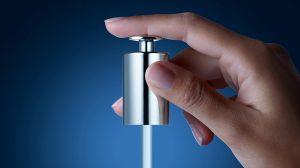
Why use a hyaluronic acid skincare product?
With age, the body's synthesis of hyaluronic acid decreases by about 10% every 10 years. The quality of the hyaluronic acid the body produces also decreases, which reduces its moisturising, plumping, and protective capacities.
If you want to take care of your skin, regular application of a hyaluronic acid skincare product makes sense.
In addition, it is important to know that the hyaluronic acid contained in the skin is broken down quite quickly. Scientists say that it has a half-life of 24 hours: this means that after one day, half of the hyaluronic acid in your skin will have been used. To replenish it and maximise its benefits, FILORGA experts therefore recommend daily or twice-daily application of hyaluronic acid skincare products.
Hyaluronic acid is an ingredient known for its cosmetic effectiveness. Our scientists have incorporated it into many of our formulas and maximised its benefits. Inspired by the work of Dr Michel Tordjman, they created NCEF [New Cellular Encapsulated Factors], the foundation of Laboratoires FILORGA's unique skincare formula. Learn more about it in this article.
Sources:
John HE, Price RD. Perspectives in the selection of hyaluronic acid fillers for facial wrinkles and aging skin. Patient Prefer Adherence. 2009 Nov 3;3:225-30. doi: 10.2147/ppa.s3183. PMID: 19936165; PMCID: PMC2778417.

